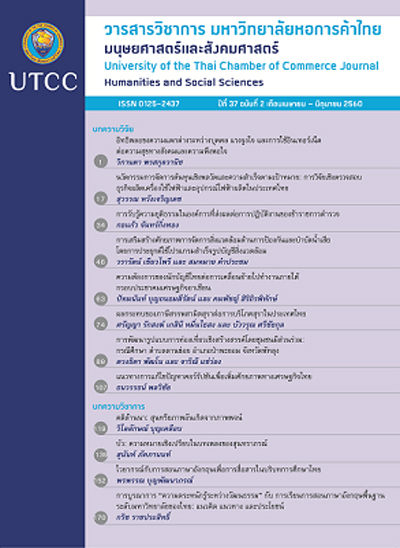กระบวนการผลิตรายการวิทยุที่เป็นเอกลักษณ์ของ NHK WORD RADIO JAPAN ภาคภาษาไทย
Main Article Content
บทคัดย่อ
การวิจัยเรื่อง กระบวนการผลิตรายการวิทยุที่เป็นเอกลักษณ์ของ NHK WORLD RADIO JAPAN ภาคภาษาไทย เป็นการวิจัยเชิงคุณภาพ ใช้วิธีการสัมภาษณ์และสังเกตการทำงาน ณ ที่ทำการของแผนกภาษาไทย NHK WORLD RADIO JAPAN กรุงโตเกียว ประเทศญี่ปุ่น รวมทั้งศึกษาหลักฐานเอกสารที่เกี่ยวข้องรวมทั้งข้อมูลจากเว็บไซต์ของ NHK WORLD และ NHK WORLD RADIO JAPAN ภาคภาษาไทย โดยมีวัตถุประสงค์ของการวิจัยเพื่อศึกษากระบวนการผลิตรายการวิทยุภาษาไทยที่เป็นเอกลักษณ์ของผู้ผลิตรายการญี่ปุ่น และเรียนรู้ถึงวิธีการทำงานร่วมกันของผู้ผลิตรายการ (Producer) ญี่ปุ่น ผู้เชี่ยวชาญ (Specialist) และผู้ประกาศ (Presenter / Announcer) ไทย ผลการศึกษาพบว่า กระบวนการผลิตรายการวิทยุของเรดิโอ แจแปน ภาคภาษาไทย ประกอบด้วยขั้นตอนใหญ่ ๆ 5 ขั้นตอน คือ 1) คิดสร้างสรรค์และวางแผน 2) รวบรวมข้อมูล 3) เตรียมการผลิตรายการ 4) เขียนบทวิทยุ 5) ฝึกซ้อมและออกอากาศ โดยผู้ผลิตรายการญี่ปุ่น เป็นผู้เริ่มต้นกระบวนการผลิตรายการตั้งแต่การคิดสร้างสรรค์รายการจนถึงขั้นออกอากาศ กระบวนการทำงานที่เป็นเอกลักษณ์ของผู้ผลิตรายการญี่ปุ่น มีสามขั้นตอน คือ (1) ผู้ผลิตรายการญี่ปุ่นเขียนบทวิทยุภาษาญี่ปุ่นเป็นลำดับแรก แล้วแปลเป็นบทวิทยุต้นฉบับภาษาอังกฤษ ส่งให้แผนกภาษาต่างประเทศทุกภาษารวมทั้งภาษาไทย จากนั้นจึงให้ผู้เชี่ยวชาญหรือผู้ประกาศไทย แปลเป็นบทวิทยุภาษาไทย (2) ดำเนินการฝึกซ้อมและออกอากาศต่อเนื่องกันโดยผู้ผลิตรายการญี่ปุ่นกำกับการฝึกซ้อมซึ่งเรียกว่าการประชุมพิจารณา (Discussion) อ่านบทวิทยุพร้อมกับบุคลากรผลิตรายการไทยเพื่อตรวจความถูกต้องของเนื้อหา การแปลบทวิทยุ การอ่านออกเสียง และจับเวลา (3) ผู้ผลิตรายการญี่ปุ่นทำหน้าที่กำกับรายการและเป็น ผู้ควบคุมการบันทึกเสียงต่อจากการฝึกซึกซ้อมทันที
Article Details
ลิขสิทธิ์ของบทความ
ผลงานที่ได้รับการตีพิมพ์ถือเป็นลิขสิทธิ์ของมหาวิทยาลัยหอการค้าไทย ห้ามมิให้นำเนื้อหา ทัศนะ หรือข้อคิดเห็นใด ๆ ของผลงานไปทำซ้ำ ดัดแปลง หรือเผยแพร่ ไม่ว่าทั้งหมดหรือบางส่วนโดยไม่ได้รับอนุญาตเป็นลายลักษณ์อักษรจากมหาวิทยาลัยหอการค้าไทยก่อน
เอกสารอ้างอิง
Chalermjirarat, V. (1988). Japanese style management (4thed.). Bangkok, Thailand: Dokya. (in Thai).
Chanvichai, K. (2005). The success of NHK’s television documentary program (Unpublished doctoral dissertation). Thammasat University, Bangkok, Thailand. (in Thai).
Crisell, A.(1994). Understanding radio (2nd ed.). New York, NY: Routledge.
Eusin, S. 2005. Teaching material of radio programme production unit 1. Nonthaburi, Thailand: Sukhothai Thammathirat Open University. (in Thai).
NHK, Public Relations Department. (2015). NHK annual report 2015/2016. Tokyo, Japan: Author.
NHK WORLD. (2015a). A history of international broadcasting from Japan, 80 years of NHK WORLD 1935-2015. Retrieved December, 16, 2015, from https://www.nhk.or.jp/intl80th/
NHK WORLD. (2015b). How is a program made: A case from the Arabic service. In A history of international broadcasting from Japan, 80 years of NHK WORLD 1935-2015, p.66-67. Tokyo, Japan: Author.
NHK WORLD. (2017a). Programme schedule. Retrieved March 5, 2017, from https://www.nhk.or.jp/nhkworld/th/radio/
NHK WORLD. (2017b). How is a program made: A case from the Arabic service. Retrieved March 5, 2017, from
https://www3.nhk.or.jp/nhkworld/en/chronology/service/radio01.html
NHK WORLD RADIO JAPAN. (2017). Service introduction [Brochure]. Tokyo, Japan: Author. (in Thai).
NHK WORLD RADIO JAPAN, Thai Section. (2017). Greeting voice from Radio Japan, Thai Section. Vol. 3/2560. Tokyo, Japan: Author. (in Thai).
Polnikornkij, V. (2015). Manual for being the radio producer and television newscaster (2nd ed.).Bangkok, Thailand: Office of Children and Youth’s Affairs. (in Thai).
Pornrungroj, C. (2014). Lerners’ identity: Educational institution’s uniqueness. Bangkok, Thailand: Office for National Education Standards and Quality Assessment.(in Thai).
Rawdkamdee, J. (1982). Radio program production handbook. Bangkok, Thailand: Chulalongkorn University, Faculty of communication, Mass Communication Division. (in Thai).
The Royal Institute. (2002). Thai dictionary of the Royal Institute 2002. Retrieved September 15, 2016, from https://www.royin.go.th/dictionary/search.php
Suwanwajokkasikij, J. (2013). The process of radio and television programming and production.Bangkok,Thailand: National Broadcasting and Telecommunication Commission. (in Thai).
Thiengburanathum, W. (1998). English-Thai dictionary. Bangkok, Thailand: Se-Education.(in Thai).
Uttamachan, V. (1998). Mass media in Japan (2nd ed.). Bangkok, Thailand: T.P. Print. (in Thai).
Uttamachan, V. (2001). Media for society reform: Key concept and lessons from various countries. Bangkok, Thailand: Chulalongkorn University Press. (in Thai).
World Radio and Television Council. (2001). Public broadcasting why? how?. Retrieved April 1, 2015, from https://unesdoc.unesco.org/images/0012/001240/124058eo.pdf
Youichi, I. (2006). Some trends in communication research and education in Japan. In Global trends in communication education and research, pp.115-131. Tokyo, Japan: NHK. Retrieved January 4, 2015, from https://eds.b.ebscohost.com.ezproxy.utcc.ac.th/eds/pdfviewer/pdfviewer?vid=2&sid=c2b347f1-18ab-4f86-99ba-647d79001226@sessionmgr4010


